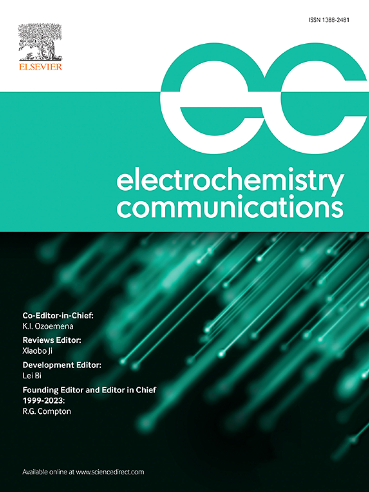Electrodeposition of uniform granular carbon on an Ag electrode by CO2 reduction in triethylpentylphosphonium bis(trifluoromethanesulfonyl)imide
IF 4.2
3区 工程技术
Q2 ELECTROCHEMISTRY
引用次数: 0
Abstract
Carbon electrodeposition on a conductive substrate from CO2 in ionic liquids is an attractive process for a unique CO2 conversion technique. This study provides a method for the electrodeposition of uniformly arranged granular carbon particles onto an Ag substrate from CO2 by potential-step application in P2225-TFSI at room temperature. The potential-step electrolysis, where the −3.0 and −0.40 V (vs. Ag+/Ag) were applied for 1 min each, followed by −1.0 V for 3.2 s for 20 sets, was conducted to reduce CO2 to silver carbonyl ions and then to solid carbon electrochemically. The SEM image with EDS elemental analysis for the electrodeposits exhibited that granular carbon particles uniformly arranged and ca. 0.4 μm in size were covered on the Ag surface. This result indicates that carbon nucleation could be preferentially induced at the Ag/P2225-TFSI interface when applying the potential in the third step for a few seconds. Raman spectroscopy and XRD analyses revealed that the electrodeposited carbon grains comprised hexagonal carbon, graphite, and η-diamond. Moreover, we proposed a model for the formation mechanism of the carbon grains on the Ag substrate in the electrolysis based on the observed morphological changes in the electrodeposited carbon when the number of times the step electrolysis was changed. The reported data demonstrated that it is possible to electrochemically control the nucleation and growth phenomena of carbon from CO2 at room temperature, which is expected to contribute to producing functional carbon materials as a novel CO2 recycling technology.
用三乙基戊基磷二(三氟甲磺酰基)亚胺还原CO2在银电极上电沉积均匀颗粒碳
离子液体中的二氧化碳在导电衬底上电沉积碳是一种独特的二氧化碳转化技术。本研究提供了一种在室温下用P2225-TFSI电极在银衬底上电沉积均匀排列的碳颗粒的方法。电位阶跃电解,−3.0和−0.40 V (vs. Ag+/Ag)各1 min,然后−1.0 V, 3.2 s,共20组,将CO2电化学还原为银羰基离子,然后转化为固体碳。镀层的SEM和EDS元素分析结果表明,银表面覆盖了粒径约0.4 μm、排列均匀的碳颗粒。结果表明,在第三步中施加几秒钟的电势,可以优先在Ag/P2225-TFSI界面诱导碳成核。拉曼光谱和XRD分析表明,电沉积碳颗粒由六方碳、石墨和η-金刚石组成。此外,我们根据观察到的电沉积碳在电解过程中随着电解次数的变化而发生的形态变化,提出了电解过程中银衬底上碳颗粒形成机制的模型。研究结果表明,在室温下电化学控制CO2中碳的成核和生长现象是可能的,这有望为生产功能碳材料作为一种新的CO2回收技术做出贡献。
本文章由计算机程序翻译,如有差异,请以英文原文为准。
求助全文
约1分钟内获得全文
求助全文
来源期刊

Electrochemistry Communications
工程技术-电化学
CiteScore
8.50
自引率
3.70%
发文量
160
审稿时长
1.2 months
期刊介绍:
Electrochemistry Communications is an open access journal providing fast dissemination of short communications, full communications and mini reviews covering the whole field of electrochemistry which merit urgent publication. Short communications are limited to a maximum of 20,000 characters (including spaces) while full communications and mini reviews are limited to 25,000 characters (including spaces). Supplementary information is permitted for full communications and mini reviews but not for short communications. We aim to be the fastest journal in electrochemistry for these types of papers.
 求助内容:
求助内容: 应助结果提醒方式:
应助结果提醒方式:


